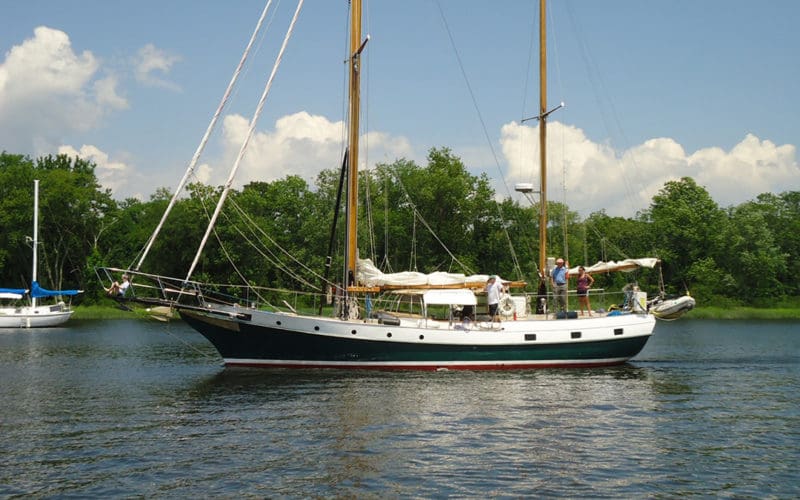
The Johnsons — Irving and Exy — weren’t your average American married couple. The Johnsons completed seven circumnavigations beginning in the 1930s, all aboard boats named Yankee, with each passage taking about 18 months. They spent their lives and raised their family while circumnavigating. Through their books and articles in National Geographic magazine, they introduced America and the world to the adventure of sailing around the world.
The first Yankee was a Dutch North Sea pilot schooner. The second Yankee, purchased in 1947, was a German North Sea pilot schooner that was re-rigged as a brigantine. They sailed this Yankee until the late 1950s. They then changed their focus and hired Rod Stephens to help Captain Johnson design their third Yankee for sailing inland waters in Europe and Africa. This last Yankee, built in 1959, is 60 feet overall, built of steel, displacing 62,000 pounds, with two fore-and-aft 1,000-pound centerboards, drawing four feet. The bottom was reinforced so that the vessel could be intentionally grounded.
Johnson claimed that this final Yankee was designed to climb mountains, cross oceans, and survive shipwreck. The most famous passage that Yankee completed was before the building of the Aswan Dam in Egypt. Yankee was the last vessel to cruise down the Nile on a 1,000-mile journey. Yankee sailed transatlantic to Trinidad in the 1970s.
Dr. Gordon Van Nes purchased Yankee in 1998 and has sailed the vessel since then from Nova Scotia to Bermuda and up and down the East Coast. After the purchase of Yankee in 1998, Van Nes spent a number of years rebuilding the vessel. Afterward, Yankee was certified by the Coast Guard to carry 22 passengers.
After owning Yankee for near 25 years, Dr. Van Nes now in his 80s, has decided to pass the boat on to another steward. For info about Yankee, go to yankeesailing.net.
Let’s join Van Nes aboard Yankee in 2012 as he sails to Halifax, Nova Scotia, from Portland, Maine. The day is July 22 and we will be using the 2021 Nautical Almanac. The DR position at the time of the observations is 41˚ 52’ N by 66˚ 20’ W. Van Nes takes his shots at exactly the time of nautical twilight. Both observations are taken at the same time. The height of eye is 10 feet and there is no error on the sextant. We’ll be using H.O 249, Volume I, Selected Stars, the 2020 epoch. Van Nes is shooting Capella and Vega. Capella has an Hs of 32˚ 10.6’. Vega has an Hs of 34˚ 24.8’.
A. What is time of nautical twilight in GMT at 66° W?
B. What is the GHA of Aries at nautical twilight?
C. What is the LHA of Aries?
D. What is Capella’s Ho?
E. What is Vega’s Ho?
F. What are the intercepts for both stars?
G. What is the fix position?
Answers
A.Nautical twilight is 0803 GMT @ 66° W
B. GHA Aries: 061˚ 02.8’
C. LHA Aries: 355˚
D.Capella’s Ho: 32˚ 06’
E. Vega’s Ho: 34˚ 20.3’
F. Capella is 3.0 NM toward and Vega is 3.3 NM toward
G. 42˚ 06’ N by 66˚ 04’ W

